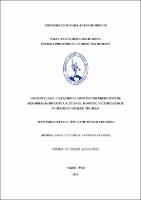| dc.contributor.advisor | Aliaga Diaz, Roger | |
| dc.contributor.author | Sanchez Murphy, Katherin Yessenia | |
| dc.creator | Sanchez Murphy, Katherin Yessenia | |
| dc.date.accessioned | 2017-05-17T23:32:25Z | |
| dc.date.available | 2017-05-17T23:32:25Z | |
| dc.date.issued | 2017 | |
| dc.identifier | T_MED_2058 | |
| dc.identifier.uri | https://hdl.handle.net/20.500.12759/2650 | |
| dc.description.abstract | Identificar si el cociente urea – creatinina mayor de 60 es un factor predictivo de
hemorragia digestiva alta en pacientes adultos del hospital Base Víctor Lazarte Echegaray
en el periodo Enero a Diciembre 2016.
Material y Métodos: Se llevó a cabo un estudio observacional, retrospectivo, de casos y
controles, de prueba diagnóstica. La muestra de la población de estudio estuvo constituida
por 90 pacientes adultos que cumplieron con los criterios de inclusión y exclusión,
distribuidos en dos grupos: 30 casos con hemorragia digestiva alta y 60 controles que no
tuvieron hemorragia digestiva alta.
Resultados:
Respecto a la edad, se obtuvo un promedio total de 62.6 años con una desviación estándar
de 17.4 años; en los casos fue de 66,7 ± 16.5 años, frente al grupo control que se obtuvo
una edad promedio de 59.4 ± 16,9 años. Encontrando que la edad y el cociente urea-
creatinina no tienen una relación estadísticamente significativa (valor –p: 0.056). Entre los
hallazgos endoscópicos más frecuente encontrados para el grupo de casos fue la úlcera
gástrica Forrest II- IV 16.7%, seguida de gastritis no especificada 13.3% y úlcera duodenal
con 10%. Se encontró que el cociente urea- creatinina tiene sensibilidad (90%) y
especificidad (95%), un valor predictivo positivo (90%), lo que se interpreta de que los
pacientes con cociente urea – creatinina mayor de 60 tienen probabilidad de tener HDA; y
esto se correlaciona con la razón de verosimilitud positiva alta (18) que indica que el
cociente urea- creatinina es un excelente predictor de HDA
Conclusiones: El cociente urea- creatinina es un factor predictivo de hemorragia digestiva
alta. | es_PE |
| dc.description.abstract | To identify if the urea - creatinine ratio greater than 60 is a predictive factor of
upper gastrointestinal bleeding in adult patients at Base Víctor Lazarte Echegaray Hospital
in the period January to December 2016..
Material and Methods: An observational, retrospective, case-control study of the
diagnostic test was carried out. The sample of the study population consisted of 90 adult
patients who met the inclusion and exclusion criteria, distributed in two groups: 30 cases
with upper gastrointestinal bleeding and 60 controls that did not have upper digestive
hemorrhage.
Results:
With respect to age, a total average of 62.6 years was obtained with a standard deviation of
17.4 years; In the cases was 66.7 ± 16.5 years, compared to the control group, which
obtained an average age of 59.4 ± 16.9 years. Finding that age and urea-creatinine ratio do
not have a statistically significant relationship (p-value: 0.056). Among the most frequent
endoscopic findings found for the group of cases was the gastric ulcer Forrest II-IV 16.7%,
followed by unspecified gastritis 13.3% and duodenal ulcer with 10%. It was found that the
urea-creatinine ratio has sensitivity (90%) and specificity (95%), a positive predictive
value (90%), which is interpreted to mean that patients with a urea-creatinine ratio above
60 are likely to have HDA. And this correlates with the high positive likelihood ratio (18)
indicating that the urea-creatinine ratio is an excellent predictor of HAD.
Conclusions: The urea-creatinine ratio is a predictor of upper gastrointestinal bleeding. | en_US |
| dc.description.uri | Tesis | |
| dc.format | application/pdf | es_PE |
| dc.language.iso | spa | es_PE |
| dc.publisher | Universidad Privada Antenor Orrego | es_PE |
| dc.relation.ispartofseries | T_MED_2058 | |
| dc.rights | info:eu-repo/semantics/openAccess | es_PE |
| dc.rights.uri | https://creativecommons.org/licenses/by/4.0/ | es_PE |
| dc.source | Universidad Privada Antenor Orrego | es_PE |
| dc.source | Repositorio Institucional - UPAO | es_PE |
| dc.subject | Hemorragia Digestiva Alta | es_PE |
| dc.subject | Cociente Urea- creatinina | es_PE |
| dc.title | Cociente urea- creatinina como factor predictivo de hemorragia digestiva alta en el hospital Víctor Lazarte Echegaray Essalud Trujillo | es_PE |
| dc.type | info:eu-repo/semantics/bachelorThesis | es_PE |
| thesis.degree.level | Título Profesional | es_PE |
| thesis.degree.grantor | Universidad Privada Antenor Orrego. Facultad de Medicina Humana | es_PE |
| thesis.degree.name | Médico Cirujano | es_PE |
| thesis.degree.discipline | Medicina Humana | es_PE |
| dc.subject.ocde | https://purl.org/pe-repo/ocde/ford#3.02.27 | es_PE |
| renati.type | https://purl.org/pe-repo/renati/type#tesis | es_PE |
| renati.level | https://purl.org/pe-repo/renati/level#tituloProfesional | es_PE |
| renati.discipline | 912016 | es_PE |
| dc.publisher.country | PE | es_PE |


